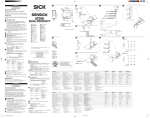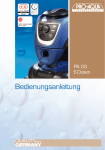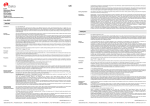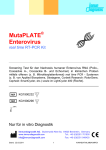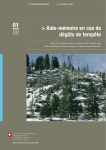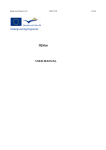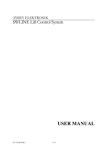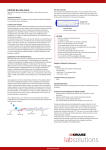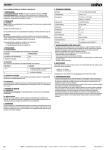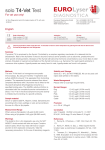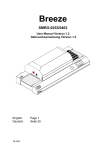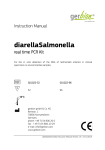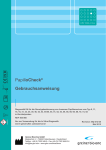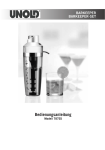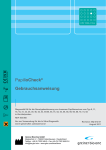Download ixSave®TBE real time RT
Transcript
Gebrauchsinformation Instruction Manual ixSave®TBE real time RT-PCR Kit TM Für den in-vitro Nachweis von FSME-Virus RNA in Zecken. For the in-vitro detection of Tick-borne Encephalitis Virus (TBEV) RNA in ticks. G01011-32 32 G01011-96 96 GmbH & Co. KG Remsstr. 1 D-70806 Kornwestheim Germany phone: +49 (0) 7154 806 20 0 fax: + 49 (0) 7154 806 20 29 e-mail: [email protected] www.gerbion.com Version 3.2/ 15.08.2013 Inhaltsverzeichnis Komponenten ........................................................................................... 3 Abkürzungen ............................................................................................ 3 Transport und Lagerung .......................................................................... 3 Anwendungszweck ................................................................................... 3 Art und Beschaffenheit des Probenmaterials ......................................... 4 Qualitätskontrolle .................................................................................. 4 Produktgewährleistung ........................................................................... 4 Einleitung ................................................................................................. 4 Testprinzip ............................................................................................... 5 Zusätzlich benötigte Materialien und Geräte ......................................... 5 Wichtige Hinweise .................................................................................. 5 Probenvorbereitung ................................................................................ 6 Real time RT-PCR ...................................................................................... 7 Interpretation der Ergebnisse ................................................................. 9 Troubleshooting .................................................................................... 11 Komponenten Die Komponenten sind ausreichend für den Ansatz von 96 bzw. 32 Nachweisreaktionen. Inhalt Bezeichnung Deckelfarbe K1 Reaction Mix g el b 2 x 760 µl 1 x 506 µl K2 Enzyme blau 1 x 19,2 µl 1 x 6,4 µl K3 Pos itive C ontrol rot 1 x 100 µl 1 x 50 µl K4 Neg ative C ontrol g rün 1 x 100 µl 1 x 50 µl 96 32 Abkürzungen cDNA PCR RNA RT copy Desoxyribonukleinsäure Polymerase-Ketten-Reaktion Ribonukleinsäure Reverse Transkription Transport und Lagerung Der Transport des ixSave®TBE real time RT-PCR Kit TM erfolgt gefroren auf Trockeneis. Alle Komponenten des ixSave®TBE real time RT-PCR Kit TM sind direkt nach Erhalt bei -18°C lichtgeschützt zu lagern. Nach Ablauf des auf der Packung angegebenen Haltbarkeitsdatums nicht mehr verwenden! Nach Anbruch der Reagenzien sind diese für maximal sechs Monate verwendbar. Mehrmaliges Auftauen und Einfrieren (> zweimal) der Reagenzien vermeiden, da dadurch die Sensitivität verringert werden kann. Gegebenenfalls sollten der Reaktions-Mix (K1) und die Positivkontrolle (K3) aliquotiert werden. Anwendungszweck Der ixSave®TBE real time RT-PCR Kit TM dient dem Nachweis FSME Virus RNA in Zecken mittels real time RT-PCR in offenen real time PCR-Systemen (z.B. von Illumina, Applied Biosystems, Stratagene). Seite 3 Art und Beschaffenheit des Probenmaterials Das Ausgangsmaterial für die Nachweisreaktion ist RNA, die aus Zecken gewonnen wurde. Qualitätskontrolle In Übereinstimmung mit dem ISO-zertifizierten Qualitätsmanagementsystem der gerbion GmbH & Co. KG wird jede Charge des ixSave®TBE real time RT-PCR Kits TM gegen vorgegebene Spezifikationen getestet, um eine einheitliche Produktqualität zu gewährleisten. Produktgewährleistung Diese Gebrauchsinformation gilt als vollständig und richtig zum Zeitpunkt ihrer Veröffentlichung. Die gerbion GmbH & Co. KG haftet keinesfalls für Neben- oder Folgeschäden, die sich im Zusammenhang mit oder in der Folge der Benutzung dieser Gebrauchsinformation ergeben. gerbion garantiert die volle Funktionsfähigkeit, wenn das Produkt entsprechend der in der Gebrauchsinformation angegebenen Anleitung erfolgt. Der Käufer muss selbst bestimmen, ob das Produkt für seine spezielle Anwendung geeignet ist. gerbion behält sich vor, Produkte jederzeit zu modifizieren, um die Funktionalität oder das Design zu verbessern. Einleitung FSME-Viren sind die Erreger der sogenannten FrühsommerMeningoenzephalitis (FSME). Diese Erkrankung verläuft mit grippeähnlichen Symptomen und Fieber, bei einem Teil der Patienten kommt es zu einer Meningoenzephalitis, der Entzündung von Gehirn und Hirnhäuten. Oft verläuft eine Infektion auch symptomlos. Überträger der Erreger sind Zecken, hauptsächlich Ixodes ricinus, der gemeine Holzbock. Eine ursächliche Behandlung der FSME ist nicht möglich. Bei einzelnen, sehr schweren Verläufen können Interferone verabreicht werden. Insgesamt beschränkt sich die Therapie auf symptomatische Maßnahmen. Neben allgemeinen Schutzmaßnahmen, wie dem Absuchen des Körpers nach Zecken, kommt die aktive Impfung als vorbeugende Maßnahme in Frage. Sie wird, national etwas unterschiedlich, für alle Personen, die sich in Risikogebieten aufhalten, empfohlen. Durch die Untersuchung der Zecke auf FSME-Viren kann das Infektionsrisiko bereits kurze Zeit nach Entdecken des Parasits abgeschätzt werden. Seite 4 Testprinzip Der ixSave®TBE real time RT-PCR Kit enthält spezifische Primer und Fluoreszenzfarbstoff-markierte Sonden für den Nachweis von FSME-Virus-RNA nach vorausgegangener RNA-Extraktion. Die Reverse Transkription (RT) der möglicherweise enthaltenen viralen RNA zu cDNA und die anschließende Amplifikation von FSME-spezifischen Fragmenten mittels PCR erfolgen in einem Schritt. Die Detektion der Amplifikation erfolgt in Echtzeit durch die Hybridisierung und anschließende Hydrolyse der FSME-Virus-spezifischen Fluoreszenzsonden. Die Detektion erfolgt im FAM-Kanal. Zusätzlich verfügt der ixSave®TBE real time RT-PCR Kit über eine Interne Kontrolle. Hierfür wird ein zeckenspezifisches Gen in einem zweiten heterologen Amplifikationssystem nachgewiesen. Dies ermöglicht zum einen das Aufdecken von Fehlern bei der Extraktion aus Zecken, zum anderen kann eine mögliche Inhibition der PCR identifiziert werden. Dadurch wird das Risiko von falsch-negativen Ergebnissen reduziert. Die Detektion der Interne Kontrolle erfolgt im HEX/VIC/JOE/TET-Kanal. Zusätzlich benötigte Materialien und Geräte • NukEx Nukleinsäurefreisetzungsreagenz (gerbion, Art. G01013) oder RNA Extraktionskit (z.B. NukEx Pure RNA/DNA, gerbion Art. Nr. G05004) • sterile Reaktionsgefäße • Pipetten (variable Volumina) • sterile Pipettenspitzen mit Filter • Thermoblock • Tischzentrifuge • Vortexer • Real time PCR Gerät (z.B. EcoTM, Illumina) • Optische PCR Gefäße mit Verschluß • Optional: Pipettiergeräte zur Automation Wichtige Hinweise • Die ixSave®TBE real time RT-PCR TM muss in für diesen Zweck geeigneten Laboratorien und von speziell geschultem Personal durchgeführt werden. • Die Richtlinien der Good Laboratory Practice (GLP) sind einzuhalten. • Alle Proben müssen als potentiell infektiös betrachtet werden und alle mit den Proben in Berührung kommenden Gegenstände müssen als potentiell kontaminiert erachtet werden. Seite 5 Allgemeine Hinweise • Die Anweisungen der Gebrauchsinformation sind einzuhalten. • Areale für die Probenvorbereitung und den Ansatz des PCR MasterMix sollten strikt getrennt sein. • Pipetten, Röhrchen und andere Arbeitsmaterialien dürfen nicht von einem Bereich in den anderen zirkulieren. • Immer Pipettenspitzen mit Filter verwenden. • Pipetten und Arbeitsflächen regelmäßig mit geeigneter Dekontaminationslösung reinigen (keine ethanolhaltigen Mittel). • Komponenten verschiedener Chargen des ixSave®TBE real time RT-PCR Kit TM dürfen nicht zusammen verwendet werden. Probenvorbereitung Die ixSave®TBE real time RT-PCR TM ist geeignet für den Nachweis von FSME-Virus-RNA in Zecken nach vorausgegangener Freisetzung oder Extraktion der RNA. Es wird empfohlen, zur Freisetzung der RNA das gerbion NukEx Nukleinsäurefreisetzungsreagenz (Art. Nr. G01013) zu verwenden. Dies ist die schnellste und einfachste Methode der Probenvorbereitung. Wird eine Extraktion der RNA bevorzugt, so empfehlen wir kommerziell erhältliche Extraktionskits zu verwenden. z.B.: • NukEx Pure RNA/DNA (gerbion, Art. Nr. G05004) Weitere Informationen zur Freisetzung oder Isolierung von RNA erhalten Sie in der NukEx Gebrauchsinformation oder der Gebrauchsinformation des Extraktionskits bzw. vom technischen Service des Extraktionskit Herstellers. Wichtig: Unabhängig vom verwendeten Probenmaterial sollte zusätzlich zu den Proben eine Wasserkontrolle (Reinstwasser) extrahiert werden, anhand derer sich eventuell auftretende Kontaminationen ablesen lassen. Diese Wasserkontrolle muss analog einer Probe behandelt werden. Falls die real time RT-PCR nicht sofort durchgeführt wird, müssen die RNA-Extrakte entsprechend der Angaben des Extraktionskit Herstellers aufbewahrt werden. Seite 6 Real time RT-PCR Wichtige Punkte bevor Sie starten: • Bitte beachten sie die „Wichtigen Hinweise“ auf Seite 6. • Bevor Sie die PCR ansetzen machen Sie sich mit dem real time PCR Gerät vertraut. Die Programmierung des Temperaturprofils sollte abgeschlossen sein, bevor die PCR angesetzt wird. • Beachten Sie, dass in jedem PCR Lauf mindestens eine Positivkontrolle (K3) und eine Negativkontrolle (K4) enthalten sein sollte. • Alle Reagenzien - bis auf das Enzym (K2) - müssen komplett aufgetaut, gemischt (Reaktions-Mix (K1) nicht vortexen, sondern durch wiederholtes Auf- und Abpipettieren mischen) und kurz abzentrifugiert werden. Halten Sie die Reagenzien stetig gekühlt in einem Kühlblock (+2 bis +8°C) oder auf Eis. Durchführung Zunächst wird ein PCR Master Mix angesetzt. Dieser Master Mix enthält alle benötigten Komponenten außer der Probe. Setzen Sie für die Gesamtzahl der geplanten PCR-Ansätze mindestens einen Ansatz mehr als benötigt an. Tabelle 1: Herstellung des Master-Mix: Reaktionsvolumen 15,8 µl Reaktions-Mix (K1) 0,2 µl Enzym (K2) Master-Mix Volumen 15,8 µl x (N+1) 0,2 µl x (N+1) • Benötigte Anzahl optischer PCR-Reaktionsgefäße in einen geeigneten Kühlblock stellen. • 16 µl des Master Mix in jedes Gefäß pipettieren. • 4 µl der RNA-Eluate (inklusive der Eluate der Wasserkontrolle) bzw. der NukEx Überstände, der Positivkontrolle (K3), und der Negativkontrolle (K4) in die entsprechenden Gefäße hinzupipettieren. • Die Reaktionsgefäße sofort nach dem die Probe zugefügt wurde verschließen, um das Kontaminationsrisiko zu minimieren. Für die real time RT-PCR das in Tabelle 2 beschriebene Temperaturprofil benutzen. Seite 7 Tabelle 2: real time RT-PCR Temperaturprofil 1. Reverse Transkription 20 min 45°C 2. Initiale Denaturierung 10 min 95°C 3. Amplifikation der cDNA Anzahl der Zyklen Denaturierung 45 15 sec 95°C Annealing 30 sec 57°C (Messung am Ende dieses Schrittes) Extension 15 sec Seite 8 72°C Interpretation der Ergebnisse Die FSME-Virus-spezifische Amplifikation wird im FAM-Kanal detektiert. Die Amplifikation der Internen Kontrolle wird im VIC®/HEX/JOETM/TET-Kanal gemessen. Folgende Ergebnisse können auftreten: • Im FAM-Kanal wird ein Signal detektiert: Das Ergebnis ist positiv, die Probe enthält FSME-Virus-RNA. In diesem Fall ist die Detektion eines Signals im VIC®/HEX/JOETM/TETKanal nicht notwendig, da eine hohe FSME-Virus cDNA-Konzentration zu einem verminderten bzw. fehlenden Fluoreszenzsignal der Internen Kontrolle führen kann (Kompetition). • Im FAM-Kanal wird kein Signal detektiert, jedoch im VIC®/HEX/JOETM/ TET-Kanal: Das Ergebnis ist negativ, die Probe enthält keine FSME-Virus-RNA. Das detektierte Signal der Internen Kontrolle schließt die Möglichkeit einer fehlerhaften RNA-Extraktion aus. Außerdem sind weder die Reverse Transkription noch die PCR komplett inhibiert. • Weder im FAM- noch im VIC®/HEX/JOETM/TET-Kanal wird ein Signal detektiert: Es kann keine diagnostische Aussage getroffen werden. Die real time RT-PCR wurde inhibiert, oder es trat ein Fehler bei der RNA-Extraktion auf. Seite 9 Abbildung 1 und Abbildung 2 zeigen Beispiele für positive und negative PCR Ergebnisse. positive Probe negative Probe Abb 1: Die positive Probe zeigt eine starke Amplifikation im spezifischen FAM-Kanal, während bei der negativen Probe kein Fluoreszenzsignal detektiert wird. negative Probe positive Probe Abb. 2: Im VIC®/HEX/JOETM/TET -Kanal zeigt die negative Probe ein Signal auf. In diesem Fall liegt keine Inhibition der real time RT-PCR vor, auch verlief die Extraktion erfolgreich. Die negative Probe ist somit als tatsächlich negativ zu werten. Weder die Positiv- noch die Negativkontrolle enthalten Zecken-RNA, daher ist kein Signal der Internen Kontrolle detektierbar. Seite 10 Troubleshooting Der folgende Troubleshooting Guide soll bei eventuell auftretenden Problemen mit der real time PCR behilflich sein. Sollten Sie weitere Fragen haben, wenden Sie sich bitte an unsere W issenschaftler unter [email protected]. Kein Fluoreszenzsignal im FAM-Kanal der Positivkontrolle (K3) • Der gewählte Kanal entspricht nicht dem im Protokoll angegebenen Wählen Sie den FAM-Kanal für die Analyse der FSME-Virus-spezifischen Amplifikation und den VIC®/HEX/JOETM/TET -Kanal für die Amplifikation der Internen Kontrolle. • Fehlerhaftes Ansetzen der real time RT-PCR Überprüfen Sie Ihre Arbeitsschritte und vergleichen Sie diese mit den in „Durchführung“ auf der Seite 8 beschriebenen Arbeitsschritten. • Fehlerhaftes real time RT-PCR Temperaturprofil Vergleichen Sie das Temperaturprofil mit dem Protokoll (Tabelle 2, Seite 8). • Falsche Lagerbedingungen des Kits, oder abgelaufenes Haltbarkeitsdatum Überprüfen Sie die Lagerbedingungen und das Haltbarkeitsdatum auf dem Kitetikett. Falls nötig, benutzen Sie einen neuen Kit und lagern Sie alle Komponenten wie auf Seite 3 unter „Transport und Lagerung“ beschrieben. Schwaches oder kein Signal der Internen Kontrolle und gleichzeitiges Ausbleiben eines Signals im FAM-Kanal • Die real time RT-PCR-Bedingungen stimmen nicht mit den im Protokoll beschriebenen überein. Überprüfen Sie die real time RT-PCR-Bedingungen (Seite 7-8). • real time RT-PCR Inhibition Stellen Sie sicher, dass Sie eine der empfohlenen RNA Freisetzungsbzw. Extraktionsmethoden benutzen (siehe„Probenvorbereitung“, Seite 6) und beachten Sie die Herstellerangaben. Seite 11 Haben Sie das NukEx Nukleinsäurefreisetzungsreagenz benutzt, verdünnen Sie die Probe 1:5 in NukEx Universal Verdünnungspuffer (gerbion Art. G01014) oder in Reinstwasser und wiederholen Sie die real time RT-PCR. Haben Sie einen RNA Extraktionskit benutzt, stellen Sie sicher, dass ethanolhaltige Waschpuffer vollständig entfernt wurden (ein zusätzlicher Zentrifugationsschritt bei hoher Geschwindigkeit vor der RNA-Elution wird empfohlen). • Verlust der DNA während des Aufarbeitungsprozesses Das Ausbleiben des Signals kann auf eine fehlerhafte RNA Freisetzung bzw. Extraktion hinweisen. Stellen Sie sicher, dass Sie eine geeignete RNA Freisetzungs- bzw. Extraktionsmethode verwenden. NukEx Nukleinsäurefreisetzungsreagenz (gerbion, Art. G01013) oder kommerziell erhältliche Extraktionskits werden empfohlen (siehe Seite 6). Halten Sie sich an das Herstellerprotokoll. • Falsche Lagerbedingungen des Kit oder abgelaufenes Haltbarkeitsdatum Überprüfen Sie die Lagerbedingungen und das Haltbarkeitsdatum auf dem Kitetikett. Falls nötig, benutzen Sie einen neuen Kit und lagern Sie alle Komponenten wie auf Seite 3 unter „Transport und Lagerung“ beschrieben. Detektion eines Signals im FAM-Kanal der Negativkontrolle (K4) • Kontamination des real time RT-PCR-Ansatzes Wiederholen Sie die real time RT-PCR in Replikaten. Falls das Ergebnis der Wiederholungen negativ sein sollte, so ereignete sich die Kontamination während der Befüllung der PCR-Gefäße. Stellen Sie sicher, dass Sie die Positivkontrolle (K3) zuletzt pipettieren und verschließen Sie die Gefäße sofort nachdem Sie die jeweilige Probe zugegeben haben. Falls die Negativkontrolle (K4) in der Wiederholung wieder ein Signal im FAM-Kanal ergibt, deutet dies darauf hin, dass eine oder mehrere Kitkomponenten kontaminiert sind. Stellen Sie sicher, dass die Arbeitsbereiche und die Geräte regelmäßig dekontaminert werden. Wiederholen Sie die real time RT-PCR mit einem neuen Kit. Seite 12 Index Components ............................................................................................. 2 Abbreviations .......................................................................................... 2 Transport and Storage ............................................................................. 2 Intended Use ............................................................................................ 2 Sample Material ...................................................................................... 2 Quality Control ........................................................................................ 3 Product Warranty ................................................................................... 3 Introduction ............................................................................................ 3 Principle of the Test ................................................................................. 3 Equipment and Reagents to be Supplied by User ................................... 4 Important Notes ...................................................................................... 5 Preparation of Samples .......................................................................... 5 Real time RT- PCR ..................................................................................... 5 Data Analysis .......................................................................................... 7 Troubleshooting ...................................................................................... 9 Components The reagents supplied are sufficient for 96 or 32 reactions. Labelling Lid Colour Content 96 K1 Reaction Mix K2 32 yellow 2 x 760 µl 1 x 506 µl Enzyme blue 1 x 19.2 µl 1x K3 Pos itive C ontrol red 1 x 100 µl 1 x 50 µl K4 Neg ative C ontrol g reen 1 x 100 µl 1 x 50 µl 6.4 Abbreviations cDNA PCR RNA RT copy Desoxyribonucleic Acid Polymerase Chain Reaction Ribonucleic Acid Reverse Transcription Transport and Storage The ixSave®TBE real time RT-PCR Kit TM is shipped on dry ice. All components must be stored at -18°C in the dark immediately after receipt. Do not use reagents after the date of expiry printed on the package. After initial opening, reagents are stable for up to six months. Avoid repeated thawing/freezing of the reagents, if necessary, aliquot kit components. Intended Use The ixSave®TBE real time RT-PCR Kit TM is a screening assay for the detection of TBE Virus RNA in ticks using real time PCR microplate systems (e.g. by Illumina, Applied Biosystem, Stratagene etc.). Sample Material Starting material for the detection assay is RNA released or isolated from ticks. page 2 Quality Control In accordance with the gerbion‘s ISO-certified Quality Management System, each lot of the ixSave®TBE real time RT-PCR Kit TM is tested against predetermined specifications to ensure consistent product quality. Product Warranty gerbion guarantees the performance of all products when used according to the instructions given in the Instruction Manual. The purchaser must determine the suitability of the product for its particular use. Should any product fail to perform satisfactorily due to any reason other than misuse, gerbion will replace it free of charge or refund the price. We reserve the right to change, alter, or modify any product to enhance its performance and design. Introduction Tick-borne encephalitis (TBE) is a viral infectious disease involving the central nervous system. Alongside with flu-like symptoms and fever, the disease can manifest as meningitis, encephalitis, or meningoencephalitis. In many cases infection remains symptom-free. TBE viruses are transmitted by the bite of several species of infected ticks, including the common castor bean tick (Ixodes ricinus). The disease is incurable once manifested; therapy is limited to symptomatic measures. Anti-inflammatory drugs, such as corticosteroids, may be considered under specific circumstances for symptomatic relief. General preventive measures such as tick-bite prevention and checking the body for ticks are recommended, however reliable prophylaxis is only assured by vaccination. Analyses of the tick for TBE virus allows for better assessment of the risk of infection shortly after removal of the parasite from the body. Principle of the Test The ixSave®TBE real time RT-PCR Kit contains specific primers and probes labelled with a fluorescent dye for the analysis of TBE virus RNA isolated or released from ticks. The reverse transcription (RT) of present viral RNA to cDNA and the subsequent amplification of TBE Virus-specific fragments are performed in a one-step RT-PCR.The detection of the amplification is carried out in page 3 real time via hybridization and following hydrolysis of the TBE virusspecific fluorescent probes. The fluorescence is measured in the FAM channel. Furthermore, the ixSave®TBE real time RT-PCR Kit contains an Internal Control: in a second heterologous amplification system, a tick-specific gene is detected. This allows not only for the detection of RT-PCR-inhibition but also of possible failures during RNA extraction/release from ticks. The risk of false-negative results is greatly reduced this way. The fluorescence of the Internal Control is measured in the VIC/HEX/JOE/TET channel. Equipment and Reagents to be Supplied by User • NukEx Nucleic Acid Release Reagent (gerbion Cat. No. G01013) or RNA extraction kit (e.g. NukEx Pure RNA/DNA, gerbion Cat. No. G05004) • Sterile microtubes • Pipets (adjustable volume) • Sterile pipet tips with filter • Thermoblock • Table centrifuge • Vortexer • Real time PCR instrument (e.g. EcoTM , Illumina) • Optical PCR reaction tubes with lid • Optional: Liquid handling systems for automation Important Notes • The ixSave®TBE real time RT-PCR TM must be performed in adequate laboratories by qualified personnel. • Good Laboratory Practice (GLP) must be applied. • Clinical samples must always be regarded as potentially infectious material and all equipment used has to be treated as potentially contaminated. General Precautions • Stick to the protocol described in the Instruction Manual. • Set up different laboratory areas for the preparation of samples and for the set up of the PCR in order to avoid contaminations. • Pipettes, tubes and other material must not circulate between those different laboratory areas. • Always use filter tips. page 4 • Regulary decontaminate equipment and benches with alcohol-free decontaminant. • Do not combine ixSave®TBE real time RT-PCR Kit TM components of different lot numbers. Preparation of Samples The ixSave®TBE real time PCR TM is suitable for the detection of TBE Virus RNA released or isolated from ticks. We recommend the release of RNA from ticks with the gerbion NukEx Nucleic Acid Release Reagent (gerbion, Cat.No. G01013). This is the easiest and fastest method for the preparation of samples. However, if the extraction of RNA is prefered, we recommend the use of commercially available kits, e.g. : • NukEx Pure RNA/DNA (gerbion Cat. No. G05004) Further information about RNA release or isolation is to be found in the NukEx Instruction Manual or the extraction kit manual/from the extraction kit manufacturer‘s technical service. Important: In addition to the samples always run a „water control“ in your extraction, possible contaminations during RNA extraction will be detectable. Treat this water control analogous to a sample. If the real time RT-PCR is not performed immediatly, store extracted RNA according to the instructions given by the RNA isolation kit manufacturer. Real time RT-PCR Important Points Before Starting: • Please pay attention to the ‚Important Notes‘ on page 4. • Before setting up the real time PCR familiarise yourself with the real time PCR instrument and read the user manual supplied with the instrument. • The programming of the thermal profile should take place before the PCR set up. • In every PCR run at least one Positive Control (K3) and one Negative Control (K4) should be included. • Prior to each use, all reagents - except the Enzyme (K2) - should be thawed completely at room temperature, thouroughly mixed (do NOT vortex the Reaction Mix (K1) but mix by pipetting up and down repeatedly), and centrifuged very briefly. Then place all reagents on ice or on a cooling block (+2 to +8°C). page 5 Procedure The Master Mix contains all of the components needed for RT-PCR except the sample. Prepare a volume of Master Mix for at least one sample more than required, in order to compensate for pipetting inaccuracy. Table 1: Preparation of the Master Mix Reaction Volume 15.8 µl Reaction Mix (K1) 0.2 µl Enzyme (K2) Master Mix Volume 15.8 µl x (N+1) 0.2 µl x (N+1) • Put the number of optical PCR reaction tubes into the cooling block. • Pipet 16 µl of the Master Mix into each optical PCR reaction tube. • Add 4 µl of the DNA eluates (including the eluate of the water control), or 4 µl of the NukEx supernatants, the Positive Control (K3), and the Negative Control (K4) to the corresponding optical PCR reaction tube • Close the optical PCR reaction tubes immediately after filling in order to reduce the risk of contamination. Real time RT-PCR Thermal Profile For the real time PCR use the thermal profile shown in Table 2. Table 2: Real time RT-PCR thermal profile 1. Reverse Transcription 20 min 45°C 2. Initial Denaturation 10 min 95°C 3. Amplification of cDNA Number of cycles Denaturation 45 15 sec 95°C Annealing 30 sec 57°C (measurement at the end of this step) Extension 15 sec page 6 72°C Data Analysis The TBE Virus-specific amplification is measured in the FAM channel. The amplification of the Internal Control is measured in the VIC®/HEX/ JOETM/TET channel. Following results can occur: • A signal in the FAM channel is detected: The result is positive, the sample contains TBE Virus RNA. In this case, detection of a signal of the Internal Control in the VIC®/ HEX/JOETM/TET channel is inessential, as high concentrations of TBE Virus cDNA may reduce or completely inhibit amplification of the Internal Control. • No signal in the FAM channel, but a signal in the VIC®/HEX/JOETM/TET channel is detected: The result is negative, the sample does not contain TBE Virus RNA. The signal of the Internal Control excludes the possibilities of RNA isolation/release failure and/or real time RT-PCR inhibition. • Neither in the FAM nor in the VIC®/HEX/JOETM/TET channel a signal is detected: A diagnostic statement cannot be made. The RNA isolation/release was not successful or an inhibition of the RT-PCR has occurred. page 7 Figure 1 and Figure 2 show examples for positive and negative real time PCR results. positive sample negative sample Figure 1: The positive sample shows specific amplification in the FAM channel, whereas no fluorescence signal is detected in the negative sample. negative sample positive sample Figure 2: The negative sample shows a signal in the VIC®/HEX/JOETM/ TETchannel. The amplification signal of the tick gene in the negative sample shows that the missing signal in the TBE Virus- specific channel (FAM) is not due to PCR inhibition or failure of RNA release/extraction, but that the sample is a true negative. Neither Positive nor Negative Control contain tick DNA, therefore, no signal in the VIC®/HEX/JOETM/TET channel is detected. page 8 Troubleshooting The following troubleshooting guide is included to help you with possible problems that may arise when performing a real time RT-PCR. If you have further questions, please do not hesitate to contact our scientists on [email protected]. No fluorescence signal in the FAM channel of the Positive Control (K3) • The selected channel for analysis does not comply with the protocol Select the FAM channel for analysis of the TBE Virus-specific amplification and the VIC®/HEX/JOE TM /TET channel for the amplification of the Internal Control. • Incorrect configuration of the real time RT-PCR Check your work steps and compare with „Procedure“ on page 6. • The programming of the thermal profile is incorrect Compare the thermal profile with the protocol (Table 2, page 6). • Incorrect storage conditions for one or more kit components or kit expired Check the storage conditions and the date of expiry printed on the kit label. If necessary, use a new kit and make sure kit components are stored as described in „Transport and Storage“, page 2. Weak or no signal of the Internal Control and simultaneous absence of a signal in the TBE Virus-specific FAM channel • real time PCR conditions do not comply with the protocol Check the real time PCR conditions (page 6). • real time RT-PCR inhibited Make sure that you use an appropriate RNA release/extraction method (see „Preparation of Samples“, page 5) and follow the manufacturer‘s instructions. If NukEx Nucleic Acid Release Reagent was used, dilute sample 1:5 in NukEx Universal Dilution Buffer (gerbion Cat.No. G0104) or in PCR grade water and repeat real time PCR. If a RNA extraction kit was used, make sure that the ethanol-containing washing buffer of the isolation kit has been completely removed. An additional centrifugation step at high speed is recommended before elution of the RNA. page 9 • RNA loss during isolation process The lack of an amplification signal can indicate that the RNA release/ extraction was not successful. Make sure that you use an appropriate isolation method. NukEx Nucleic Acid Release Reagent (gerbion Cat.No. G01013) or commercial extraction kits are recommended. Stick to the manufacturer‘s protocol. • Incorrect storage conditions for one or more components or kit expired Check the storage conditions and the date of expiry printed on the kit label. If necessary, use a new kit and make sure kit components are stored as described in „Transport and Storage“, page 2. Detection of a fluorescence signal in the FAM channel of the Negative Control (K4) • Contamination during preparation of the real time RT-PCR Repeat the real time RT-PCR in replicates. If the result is negative in the repetition, the contamination occured when the samples were pipetted into the optical PCR reaction tubes. Make sure to pipet the Positive Control (K3) last and close the optical PCR reaction tube immediately after adding the sample. If the same result occurs, one or more of the kit components might be contaminated. Make sure that work space and instruments are decontaminated regularly. Use a new kit and repeat the real time RT-PCR. page 10


























